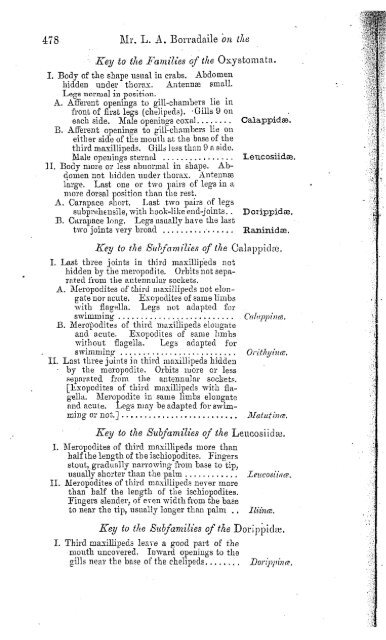On the Classification of the Decapod Crustaceans. By L. A. ...
On the Classification of the Decapod Crustaceans. By L. A. ...
On the Classification of the Decapod Crustaceans. By L. A. ...
Create successful ePaper yourself
Turn your PDF publications into a flip-book with our unique Google optimized e-Paper software.
478 Mr. L. A. Borvadaile on <strong>the</strong><br />
Key to <strong>the</strong> Families <strong>of</strong> <strong>the</strong> Oxysfcomata.<br />
I. Body <strong>of</strong> <strong>the</strong> shape usual in crabs. Abdomen<br />
hidden under thorax. Antennas small.<br />
Legs normal m position.<br />
A. Afferent openings to gill-chambers lie in<br />
front <strong>of</strong> first legs (chelipeds). -Gills 9 on<br />
each side. Male openings coxal Calappidae.<br />
B. Afferent openings to gill-chambers lie on<br />
ei<strong>the</strong>r side <strong>of</strong> <strong>the</strong> mouth at <strong>the</strong> base <strong>of</strong> <strong>the</strong><br />
third maxillipeds. Gills less than 9 a side.<br />
Male openings sternal<br />
Leucosiidae.<br />
II. Body more or less abnormal in shape. Abdomen<br />
not bidden under thorax. Antenna?<br />
large. Last one or two pairs <strong>of</strong> legs in a<br />
more dorsal position than <strong>the</strong> rest.<br />
A. Carapace short. Last two pairs <strong>of</strong> legs<br />
subprehensile, with hoot-like end-joints. . D orippidae.<br />
B. Carapace long. Legs usually have <strong>the</strong> last<br />
two joints very broad<br />
Raninidae.<br />
Key to <strong>the</strong> Subfamilies <strong>of</strong> <strong>the</strong> Calappidre.<br />
I. Last three joints in third maxillipeds not<br />
hidden by <strong>the</strong> meropodite. Orbits not separated<br />
from <strong>the</strong> antennular sockets.<br />
A. Meropodites <strong>of</strong> third maxillipeds not elongate<br />
nor acute. Exopodites <strong>of</strong> same limbs<br />
with flagella. Legs not adapted for<br />
swimming<br />
B. Meropodites <strong>of</strong> third maxillipeds elongate<br />
and acute. Exopodites <strong>of</strong> same limbs<br />
without flagella. Legs adapted for<br />
swimming<br />
II. Last three joints in third maxillipeds hidden<br />
• by <strong>the</strong> meropodite. Orbits more or less<br />
separated from <strong>the</strong> antennular sockets.<br />
[Exopodites <strong>of</strong> third maxillipeds with flagella.<br />
Meropodite in same limbs elongate<br />
and acute. Legs may be adapted for swimming<br />
or not.]<br />
Caluppinm.<br />
Oi-ithyincc.<br />
MatutincE,<br />
Key to <strong>the</strong> Subfamilies <strong>of</strong> <strong>the</strong> Leucosiidaj.<br />
I. Meropodites <strong>of</strong> third maxillipeds more than<br />
half <strong>the</strong> length <strong>of</strong> <strong>the</strong>ischiopodites. Fingers<br />
stout, gradually narrowing from base to tip,<br />
usually shorter than <strong>the</strong> palm<br />
II. Meropodites <strong>of</strong> third maxillipeds never more<br />
than half <strong>the</strong> length <strong>of</strong> <strong>the</strong> ischiopodites.<br />
Fingers slender, <strong>of</strong> even width from <strong>the</strong> base<br />
to near <strong>the</strong> tip, usually longer than palm . .<br />
Zeucosiincs.<br />
lliinm.<br />
Key to <strong>the</strong> Subfamilies <strong>of</strong> <strong>the</strong> Dorippida?.<br />
I. Third maxillipeds leave a good part <strong>of</strong> <strong>the</strong><br />
mouth uncovered. Inward openings to <strong>the</strong><br />
gills near <strong>the</strong> base <strong>of</strong> <strong>the</strong> chelipeds<br />
Borqipina?.
















